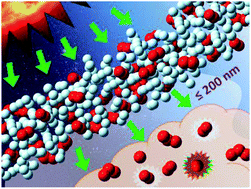Thresholds of photolysis of O2 and of formation of O3 from O2 dispersed in solid neon
Abstract
Irradiation of O2 dispersed in solid Ne with ultraviolet light produced infrared absorption lines of O3 and emission lines from atomic O (1D2 → 3P1,2), molecular O2 (A′ 3Δu → X 3Σg) and radical OH (A 2Σ+ → X 2ΠI) in the visible and near-ultraviolet regions. The threshold wavelength for the formation of O3 was determined to be 200 ± 4 nm, corresponding to energy 6.20 ± 0.12 eV, which is hence the threshold for dissociation of O2. The thresholds of emission from excited O (1D2), O2 (A′ 3Δu) and OH (A 2Σ+) were all observed to be 200 ± 4 nm, the same as for the formation of O3 in this photochemical system. The results indicate that, once O3 was generated, it was readily photolyzed to produce the long-lived atom O (1D2). Further reactions of O (1D2) with O3 produced excited O2 (A′ 3Δu); reaction with water yielded radical OH (A 2Σ+). These results enhance our understanding of the evolution of the transformation of oxygen and open a window for the understanding of complicated processes in the solid phase.



 Please wait while we load your content...
Please wait while we load your content...